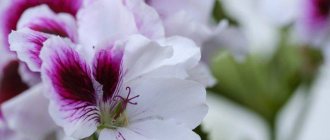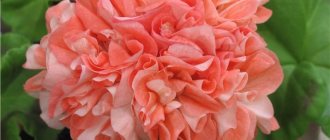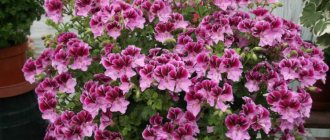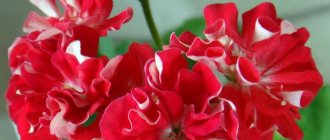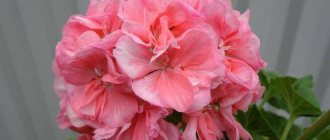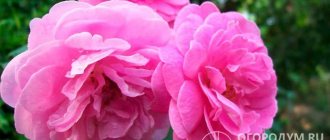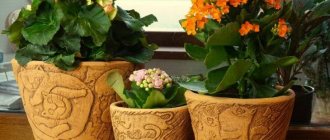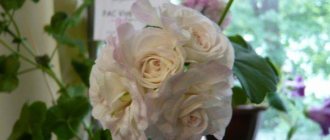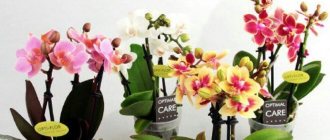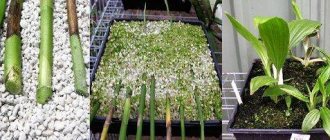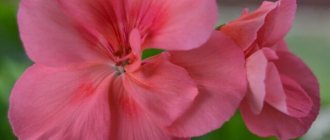Pelargonium ivy-leaved is familiar to many. Upright bushes can be seen on the windowsills of houses or growing in the garden, but hanging climbing varieties are only gaining popularity among gardeners. One of the most famous varieties of ampels of this plant is called ivy-leaved pelargonium. You can decorate your balcony with it or plant it on the window. Often this particular variety is used to create vertical gardening. The universal variety can be grown in the garden on a regular flat area. Here it will look like a dense green carpet with bright, catchy colors.
Description of popular varieties of pelargonium from the Toscana series
Pelargonium PAC Viva Madeleine, Carolina and other varieties
Thanks to the work of breeders, the color palette is wide, from soft marshmallow (Regina variety) to rich scarlet with dark spots (Dark Red variety). Varieties differ in color, shape, size and type of inflorescences.
Toscana Bernd
Pelargonium Toscana Bernd is a double and zonal beauty. Rare deep red color of inflorescences collected in bright bunches. Pelargonium Tuscany Bernd blooms profusely, covering the entire top with red balls.
Toscana Edwards
Pelargonium with red-orange inflorescences is distinguished by a white lining on the back of the petals and at their base. Pelargonium Edwards Tuscany blooms earlier than its sisters and blooms for a long time.
Edwards Tuscany
Toscana Renske
The red-burgundy small inflorescences of this variety densely cover the surface of the compact bush. The plant can be used as a hanging or potted plant. Blooms early and blooms for a long time.
Toscana Castello
Varieties of this variety come in many shades of red and pink. The inflorescences are dense and resistant to fading. The bush is medium, erect, suitable for planting in flower beds.
Toscana Hero
A beautiful combination of dark red-pink spots on the petals, with a white tint. The hiro bush is dwarf, and the inflorescences themselves are very large. The velvet shade shimmers in the sun. Blooms profusely, almost continuously. Medium size with the same flower color - Tammo geranium.
Variety Hero
Appearance and characteristics of pelargoniums
There are about 250 varieties of Pelargonium Toscana. The most favorite plants of gardeners are Bernd pelargonium, Regina species, Tammo and others.
The stem of the flower can be straight or curly, and the leaves can be carved and terry. But the defining characteristic feature is the inflorescences themselves - bright or soft pink flowers of 4 petals, which are collected together into a bouquet.
Royal pelargonium is valued for the unusual color of its semi-double petals.
This is interesting! Sometimes in descriptions the flower is called “Tuscan geranium”, but this is wrong, pelargonium just belongs to the geranium genus.
Planting and further care of ivy-leaved pelargonium Tuscany
The non-capricious Tuscany geranium grows wonderfully both in pots and in flower beds in the summer.
Pelargonium SOUTH Shukar, Aksinya, Ireland and other varieties
When planting bushes in open ground, it is important to consider that the roots of the plant are quite long. The depth of the hole should be at least 20 cm. The average distance between standard bushes is 30-35 cm.
Watering, spraying and fertilizing
Watering is needed moderate but regular. The plant will not tolerate stagnation of moisture, nor will it tolerate drying out of the soil.
Important! Spraying will not be beneficial, since moisture will only be retained on the pile of terry leaves.
To maintain flowering, it is important to fertilize the bush once every 14 days, feeding pelargonium with a universal complementary food for flowering plants. In winter, the plant takes a break from fertilizers.
Trimming
Pruning is carried out for the purpose of:
- forming a compact bush;
- for thickening the bush;
- to stimulate flowering by removing shoots that are too long.
Pelargonium pruning should be done on an ongoing basis, starting from early pinching of the cuttings.
Reproduction
Seeds or cuttings are used to propagate Tuscany pelargonium. In the first case, it is recommended to purchase seeds from flower or garden stores. If you collect them yourself, you can grow a plant that is different from the mother one.
It is necessary to plant seeds for growing seedlings in January-February. Landing is carried out in the following sequence:
- The container is filled with earth. The seeds are immersed in it. They are sprinkled with a small layer of soil on top.
- A film is stretched over the container for a greenhouse effect. The planting should be moved to a warm, bright place.
- After 5-7 days, shoots will begin to appear.
- When 2 full-fledged leaves appear on the seedlings, a dive is carried out. 2 young plants are planted in each pot.
- Pelargonium is pinched when about 5-6 leaves appear.
The branches that remain after pruning are suitable for cuttings. You can also cut them specifically for propagation. Their length should exceed 2.5 cm. The cut site is treated with a product that stimulates root growth.
Such branches are planted in moist soil. The pots are not covered. The air temperature should be about 21 degrees. Regular watering is required. Usually after 2-3 weeks the cuttings take root. When 5-6 leaves appear, the plant must be pinched.
Diseases and pests. Means to combat them
The smell of leaves and flowers repels many pests and insects. Whiteflies or spider mites can live on greenery if preventative treatments are not carried out on time.
Pests on geraniums
Improper watering regime contributes to the formation of gray rot, powdery mildew, and rust.
Pelargonium is a wonderful decoration for any home interior or garden bed. Its unpretentiousness and continuous flowering in the summer season make it a favorite of gardeners.
Care
For active growth and long-term flowering of the bush, you need to properly care for it. Growing ampelous pelargonium differs from geranium.
Light
This is one of the crops that is not afraid of the sun and burns. Ampelous pelargonium prefers an abundance of light, which is necessary for the development of the plant. It is not recommended to place the pot with it on the north window. It can only fully bloom on the south side. If this is not possible, then the flower needs to be illuminated with artificial light.
Temperature
On hot days, the temperature in the house should not rise above 32 degrees, otherwise the bush will simply burn. In winter, the air should warm up to at least 15 degrees. But even at this temperature, the bush can continue to bloom.
Watering and spraying
The plant is not afraid of dry air in the room, it does not need to be sprayed, but on hot days it needs to be watered every day. But at the same time, the flower has an extremely negative attitude towards flooding with water. Its leaves quickly rot when moisture accumulates. To prevent this from happening, water it at the root so that water does not flood the plant.
Overflows of water are worse for her than dry soil. In summer, the plant is watered a little every day. But if the soil at a depth of three centimeters has not had time to dry since the last watering, then watering must be rescheduled; even on the hottest days, the bush is not sprayed.
In winter, watering is reduced and depends on the temperature in the room. Watering once a week in winter is usually sufficient.
Priming
The best substrate for an ampel would be loose soil with an abundance of nutrients. To prepare it, you should take sand, peat and turf in equal parts, and thoroughly mix the ingredients together.
Such soil retains water and does not allow it to stagnate in the root area. When growing a house, a drainage layer must be laid out at the bottom of the container. The container for the ampel should be such that the stems can hang freely. Typically, flowerpots or pots placed on balconies are used for these purposes.
Fertilizer
It is necessary to feed the climbing plant during the entire flowering period. It is recommended to fertilize the bushes once every seven days, enriching the soil with humus or mineral compounds. The rest of the time, the amount of fertilizing is reduced and the flower is fed approximately once every 20 days. In spring and summer, the plant should be fed with compounds containing potassium and phosphorus. At other times of the year, the soil should be enriched with organic fertilizers and humus.
An alternative fertilizer can be “milk water”. Milk is simply diluted with water in a ratio of one to two. This solution saturates the leaves and other parts of the plant with nutrients.
Bush formation
To ensure that the bush always remains lush and dense, it should be pruned. It is best to do this in the spring, when the plant has just “woke up”. It is necessary to cut off all branches, except those that have two to four nodes.
Cutting is done only with a knife. You cannot pick them with your hands or break them off, because the flower quickly begins to rot. In case of severe injury to the plant during pruning, the “wounds” must be treated with crushed charcoal. As a result of the procedure, the base of the cutting should remain on the bush, and not on the cut leaf. Pruning and shaping the bush allows you to give ivy-leaved pelargonium the desired shape and remove diseased branches.
About the plant
The average height of Himalayan geranium bushes ranges from 30 to 60 centimeters. It has large leaves and bright large flowers that reach 5 centimeters. The predominant shades are blue and violet, often with well-defined veining, but the appearance depends on the specific variety. The flowering period is from May to September.
The variety of geranium varieties is amazing. This indicator allows you to choose both standard bushes and, for example, dwarf bushes, the height of which will be only about 30 centimeters.
However, the most famous variety is considered to be “Plenum”. Its peculiarity is its large double flowers that attract attention.
My collection of pelargoniums (treeland.ru), catalog
I am compiling a catalog of my collection of pelargoniums (treeland.ru), which is still small, because... For the first time, we began to seriously engage with these indoor plants recently, in the spring of 2022.
Name of the variety, description, price of cuttings upon purchase, photo of how this pelargonium looks like an adult plant, and my plant.
Rosaceae pelargoniums
Rosebud Zonal pelargoniums, or rosebuds. Densely double flowers, similar to half-open roses.
Swanland Pink/Australien Pink Rosebud
Swanland Pink / Australien Pink Rosebud – 300 RUR, rosaceous, purchased in spring 2022. Rosaceous varieties are unpretentious and bloom luxuriantly. The size is standard and can be planted in a flower bed in the garden in the summer.
Appleblossom Rosebud - 300 rubles, rosaceous, purchased in spring 2017. Rosaceous varieties are unpretentious and bloom luxuriantly. The size is standard, you can easily plant it in a flowerbed outside in the summer.
flowers April Snow
April Snow – rosaceous compact pelargonium, zonal, tricolor pink flowers with a white center – 350 rubles, purchase summer 2022.
Magnus
Bright red variety of semi-double (not rosaceous) pelargonium, purchase summer 2022, 350 rub.
Pelargonium zonale (Pelargonium zonal) / Toscana Magnus (Tuscany Magnus). It differs from other similar varieties (Rosé Down, Madame Bovary, Wendy Jane) by its unique flowers. A beautiful variety. Semi-double zonal pelargonium, compact standard.
What's good?
Special red! This red is dark, rich, deep, velvety. Once you see it, it's hard not to fall in love! If you want red pelargonium, this is one of the best!
In the heat of the sun, the edges seem to bake, resulting in a flower with a dark edge. When flowering fades, silvery streaks often appear.
Varieties similar to Magnus:
Tulip pelargoniums
They belong to the terry zonal variety.
What varieties are there?
List: Emma fran Bengtsbo (is), Pac Happy Birthday, Mrs Charles, Prince Gustav, Marbacka Tulpan, Red Pandora, Linnea Andrea, Patricia Andrea, Marie Louse, Lilian Andrea, Conny, Carmen Andrea.
Emma fran Bengtsbo
flowers Emma fran Bengtsbo
Emma fran Bengtsbo – tulip-shaped zonal pelargonium.
Blooms with light white and pink tulips, abundant flowering, standard bush - 450 rubles, purchase in autumn 2022.
Fragrant pelargoniums
Pelargonium Scented-leaf.
Scented-leaved pelargoniums have unique scents reminiscent of various herbs, flowers and fruits. Fragrant pelargoniums form a group of varieties, leaves
(not flowers) that emit fragrances. The leaves can smell like pineapple, peach, apple, grapefruit, oriental spices, roses, pine needles, wormwood, mint, etc.
Varieties and aromas of fragrant pelargoniums:
Apple Betty - apple scent Attar Of Roses = Capitatum - rose scent Atomic Snowlake - rose-lemon scent Ardwic Cinnamon - wormwood and spice scent Islington Peppermint - pure mint scent, no impurities Lavender Lindy - lavender scent Deerwood Lavender Lad - lavender scent Godfrey's Pride - "perfume" with notes pine, spices and mint Fair Ellen – “forest”, woody scent Fernleaf – aroma of pine needles p. Moliconum - pineapple scent Brilliantine - perfume scent, like cologne Fruity - sweet fruity scent Orange Fizz - strong lemon zest scent Candy Dancer - rose scent P.grossularioides - sweet, confectionery scent, with hints of coconut p. odoratissimum – apple scent Lady Plymouth – menthol scent Gemstone – subtle lemon balm scent Orsett – pine scent (juniper, cypress) Clorinda – bright spruce needle scent Fragran – clear wormwood scent Staghorn Oak – strong “forest” scent Cuculatum – sweetish scent with incense, leaves fleecy, not carvedWhite Unique, Paton's Unique, Robin's Unique - pine-resinous smell, three different aromasGrossularioides - sweet coconut smell Chocolate PeppermintSweet MimosaRober's Lemon RoseFrafrans Variegatum
Further see below, with photos
.
Most of the fragrant geraniums appeared in the process of crossing species of pelargonium. But some of them are themselves species (for example, p. Odoratissimum - the most fragrant pelargonium).
In the 18th century, fragrant geranium was used in rich homes as a natural air freshener and “perfume” on the windowsill. Until now, this plant is very popular among amateur gardeners and private collectors.
Ardwick Cinnamon
Ardwick Cinnamon - 250 rub.
The scent is fragrant cinnamon, purchased in spring 2022. Pelargonium with the scent of cinnamon, has bluish leaves, velvety to the touch, small-leaved.
Cy's Sunburst
Cy's Sunburst – 300 rubles, fragrant lemon, purchased in spring 2017. With a lemon aroma, not a capricious variety at all, variegated , yellow-green variegation, smell of lemon candy (sweet). Small-leaved variety, does not require large pots, grows slowly. Curly, small-leaved, fragrant. The smell is very sweet.
P. crispum Peach Cream - 150 rub.
Fragrant lemon, purchased in spring 2022. With a lemon aroma, not at all a capricious variety, variegated , beige-cream variegation, lemon scent.
Small-leaved variety, does not require large pots, grows slowly.
p. crispum "Variegatum". This fragrant pelargonium is rich in names, it is called Prince Rupert, French Lace, Variegated Lemon Scented Pelargonium, all these names characterize the same variety. It blooms with pale lavender flowers with darker streaks on the top two petals.
Royal Oak
Royal Oak - 100 rub.
Fragrant resin, purchased in spring 2022. Smells of resin and turpentine. In the sun, a dark zone appears on the leaves, and the leaves themselves are in the shape of oak leaves, hence the name (Royal Oak).
Charmay Snowflurry
Charmay Snowflurry is a fragrant variegated pelargonium.
Smell of balm, lemon – 300 rub.
Purchase autumn 2022.
Mabel Gray
Mabel Gray is fragrant, strong and distinct lemon scent.
Stunningly pleasant clean lemon aroma – 300 rubles, purchase autumn 2022.
Radens
Radens – fragrant, rose scent – 250 rub.
Unusual leaf shape, purchased in autumn 2022.
P. graveolens cv Bontsorai
P. graveolens cv Bontsorai 350 rub.
Curly leaves, lemon-melissa scent, purchased in autumn 2017.
Torrento (Cola)
Torrento (Cola) 250 rub.
Fragrant pelargonium, the smell of Coca-Cola drink, purchased in autumn 2017.
Poquito
Poquito 250 rub.
Fragrant pelargonium with interesting leaves, purchased in autumn 2017.
Pelargonium is the most fragrant
Fragrant pelargonium with a very strong aroma, purchased in summer 2017 (adult plant). Pelargonium (Pelargonium odoratissimum): fragrant, or fragrant, or strong-smelling, or aromatic.
An old house plant. Used for both medicinal and perfume purposes. A bush with grape-like leaves covered with small hairs. Even at the slightest touch, they fill the room with a healing fragrance.
Dry perfumes (potpourri) are made from aromatic pelargonium and used in cosmetology and cooking.
For otitis media, twist a leaf of the plant into a tube and insert it into the ear, this reduces ear pain (that’s why one of the names of this plant is ear
pelargonium).
Angels
Unidentified variety, Pelargonium-Angel.
PAC Tommy, ampelous pelargonium
PAC Tommy (gift), purchased in spring 2022. Ampel, ivy-leaved, double flowers, dark blueberry color with a velvet texture on the petals. Dense shiny leaves.
Ivy-leaved pelargoniums - profusely blooming with dense leaves, shaped like ivy.
Autumn - standard, zonal.
It blooms very elegantly with large inflorescences of large flowers of a very rich orange color with a light center - 400 rubles. (grown up), acquisition autumn 2022.
Ludwigsburger Flair, terry
Ludwigsburger Flair – double zonal pelargonium.
Flowers with very beautiful color transitions from beige-green to crimson tones, large-capped variety, in life they look like hydrangea - 200 rubles, purchase autumn 2022.
Mallorca, cactus flower
Mallorca – cacti-flowered zonal pelargonium, standard. The flowering is very interesting with variegated flowers with red strokes on the petals - 300 rubles, purchase in autumn 2022.
Cactus-flowered Zonal pelargoniums. Flowers with elongated long petals, sometimes curled into a tube, resemble the flowering of cactus dahlias or some types of cacti.
Brookside House of Orange RUB 350, purchased fall 2022. Spectacular bright light leaves, bright orange flowers.
Variegated zonal pelargoniums (Variegated, Colored, Fancy-leaved pelargoniums), or variegated. They have variegated patterned leaves of various shapes and colors.
Many of the variegated varieties are listed above as fragrant, here are those that are not fragrant
.
Contrast
Contrast 450 RUR, variegated pelargonium, purchased in autumn 2017. Magnificent variegated leaves.
Frank Heldy 400 RUR, variegated pelargonium, purchased in autumn 2022. Green with white and beige variegation, pink flowers.
Happy Thought 350 rub., purchase autumn 2022. Variety with beautiful variegated leaves. There is also a pink variety.
See the classification of pelargoniums, analysis of varieties that can be grown from seeds.
- Not yet, maybe next year.
- Hello. Beautiful and large collection. I was very interested in fragrant pelargoniums. Where did you buy them? February 10, 2022 Guest (Olga)
- I collected for a long time, searched on the Internet, ordered from different people. Unfortunately, after the first winter the losses were simply huge. All miniature-small-leaved varieties died, as well as many ordinary ones. Literally 20 percent of the purchased seedling cuttings survived until spring. Now I’m sitting here thinking, should I try again this year or what?
- Good day! Is it possible to buy fragrant pelargoniums? April 28, 2019 Guest (Marina)
- Good afternoon, have you started selling cuttings? April 28, 2022 Guest (Ekaterina)
- By mail no, I won't risk it. Where are you geographically? There was/is something, but it diverges nearby here.
- May 6, 2022 Guest (Ekaterina)
- I have a region, the outskirts, far away...
- June 19, 2022 Guest (Igor)
- I’m not selling it yet, but there are a lot of good offers on VK and on the Internet in general.
- Hello. Please tell me the name of this pelargonium. I bought it second hand. The inscription has been erased. June 24, 2022 Guest (Tamara)
- This (it seems) seems like something from royal/angels, but the variety... there are hundreds of them, it’s impossible to recognize.
- How to buy pelargoniums with the scent of rose and cinnamon? November 19, 2019 Guest (Elena)
- Also “The most fragrant Pelargonium”, price not specified. November 19, 2019 Guest (Elena)
- I don’t have it for sale, I’m looking for it and collecting it myself, there are a lot of offers on VK, fortunately there are a lot of people involved in pelargoniums.
Source: https://www.treeland.ru/article/home/houseplants/My-collection-of-geraniums
Pelargonium Toscana Malaika
Plants with this shipping deadline are sent out from April 1 to May 30 in the order in which orders are received.
Plants with only one delivery date !
For all planting material
Dozens of payment methods
Fast and convenient delivery
Russian Post (Moscow and region within 24 hours), SDEK, Courier
| Flower diameter | 14 cm |
| Flowering period | May-July |
| Delivery standard | ZKS, pot P9 |
| Flower color | raspberry pink |
| Location | Sun/partial shade |
Pelargonium Toscana Malaika (Tuscany Malaika).
Ivy-leaved pelargonium. Ivy-leaved pelargonium grows in an ampoule. Flowering is very abundant, the flower size is large. Indispensable for balcony gardening and hanging flower pots!
Planting pelargonium: Even a novice gardener can plant pelargonium in the garden - the process does not require compliance with any complex rules. You just need to remember about the long roots of the plant when digging holes about 20 cm deep. When planting, it is better to leave a distance of 20-30 cm between the bushes.
Caring for pelargonium: Pelargonium requires systematic moderate watering: the soil should not be allowed to dry out or there should be a large amount of moisture in the soil. The flower does not need spraying. Garden varieties of pelargonium do well in partial shade; flowering is weak in direct sunlight. Therefore, on particularly hot days, darkening is required. The optimal air temperature for garden plants is no more than +20 °C.
Soil for planting: Pelargonium Toscana Malaika (Tuscany Malaika) is quite demanding on the soil. The ideal solution is unused, loose soil with good drainage. For young plants without a formed root system, light soil is more suitable, so sand and peat, vermiculite and perlite are added to the composition. The soil for planting must be sufficiently fertile and well-drained. Pelargonium should not be planted in loamy and clayey soils.
Preparing for winter: Already in the fall, the pot with the plant is placed in a cool and dimly lit place. A southern or northern window sill in a house/apartment is quite suitable for this, since there is diffused sunlight there. And to make up for the lack of light at this time, you can use fluorescent lamps. The optimal daylight hours are 12 hours.
Planting location: The ideal location in the garden for pelargonium Toscana Malaika (Tuscany Malaika) would be sunny areas. However, even in partial shade it is able to fully develop and bloom profusely throughout the season.
Reproduction of pelargonium by cuttings: You need to prepare a sharp knife or scalpel and disinfect it with alcohol. In no case should you use a blunt instrument, as this can damage the tissue of the cuttings and slow down the growth of future roots. Cuttings are cut from shoots directed at right angles to the main one, and at least 3 leaves should grow on them. For tall varieties of geranium, the length of the cuttings should be about 5-7 cm, for short and miniature varieties - 2.5-4 cm. The cut is made at right angles to the stem.
The Gardens of Eden online store will help make your dreams of creating the perfect garden come true. We will be useful for professional and novice gardeners, for collectors of rare varieties, for landscape designers, for communities of joint purchases. We work directly with the largest and most time-tested manufacturers of planting material, from all over Europe and Russia. And we offer for sale without intermediaries seedlings of ornamental perennial plants, shrubs, trees, conifers, as well as fruit and berry and bulbous plants. We also have our own production of perennial plants, which we grow for you with love and care. All plants are adapted to the Russian climate. Our assortment includes thousands of different varieties, as well as exclusives and new items. We carefully select only the best offers, eliminating unscrupulous manufacturers with possible mis-grading. Carefully designed packaging allows plants to be delivered in excellent condition even to the far corners of the country. We love our customers, therefore we take a very responsible approach to the issue of the quality of planting material, and are also responsible for the work of the Russian Post and transport class=”aligncenter” width=”650″ height=”610″[/img]
Quality guarantee For the entire range
Plant varieties and popular winter-hardy varieties
Sutarve nadya k pelargonium
For flower lovers, several varieties of geranium have been bred, not only distinguished by their ease of cultivation and care. Many of them have an extremely interesting exterior.
"Canon Mills" is a popular variety of geranium with beautiful light pink flowers of uniform color. The variety is just winning the hearts of florists, but has every chance of becoming one of the favorites on the list of favorite varieties. "Alan Bloom" is a geranium variety distinguished by its soft pink flowers. One of the most common varieties of geranium. Has high frost-resistant properties. Unpretentious, suitable for growing in most climate zones. "Striatum" is a summer flower. The peculiarity is the large number of flowers. The striatum is literally completely covered with inflorescences. The variety is very popular in garden and park compositions due to its abundant, long-lasting flowering. This variety is also often called crane grass because of the fruits formed after flowering, which are very similar to the beak of a crane. "Max Fry" is one of the most popular varieties of geranium among garden designers. The plant has large, densely arranged pink flowers.
The flowers attract attention with clearly defined dark veins. “Horizon” is the common name for several varieties of geranium, among which the most popular are Horizon Red Ice and Horizon Star.
The varieties have interesting flower colors, with a contrasting border around the edges.
Variety Striatum
- "Album" is a geranium variety with delicate white flowers and specific decorative foliage. Album is a large-flowered variety; the flower diameter often reaches 3-3.5 cm. Album tolerates frost well and has a long flowering period.
- “Maxima” is a geranium with large double flowers with a bright, rich cherry edging. Maxima gets along well with other types of geranium, while emphasizing its individuality.
- “Maverick Star” is a variety characterized by a compact bush structure, a large number of inflorescences and dense, rich foliage. Maverick will appeal to those who do not have the opportunity to have a large flower bed.
- "Vision pink" is one of the most compact types of geranium. Vision is a small bush, only 15 cm in height, which goes well with tall plant species.
Botanical description, history of occurrence and cost of seeds
Zonal pelargonium is a herbaceous perennial native to hot South Africa. It has been actively decorating many homes for several centuries. Pelargonium was first brought to Europe in the 17th century, after which it received wide demand in landscape design and for decorating windows.
The following advantages of zonal pelargonium can be highlighted:
- ease of care;
- long flowering;
- beautiful shape of buds;
- fragrant aroma.
You can purchase zonal pelargonium seeds in Moscow for 31-120 rubles, depending on the variety.
Where and how to plant?
The process of planting zonal pelargonium is not difficult if you properly prepare the soil, pot and choose a suitable place.
Lighting and location
In order for the plant to actively grow, form a lush green crown and bloom profusely, it requires bright light for 4-8 hours a day. The south side is best. In the hot season, you will have to take care of shading to avoid sunburn. In summer, the temperature should be 20-23 degrees during the day, and 12-15 degrees at night.
In the cold season, it is better to keep the flower at a temperature of 12-20 degrees. During flowering, geraniums must be protected from drafts and from contact with cold glass on windows.
Soil requirements
Soil for zonal pelargonium can be used purchased or prepared independently.
In the second case, you need to take ordinary garden soil and combine it with river sand in equal proportions. In addition, you need to take care of drainage using expanded clay.
Description
Ivy-leaved pelargonium, a native of South Africa, captivated European travel scientists with its beauty. The unprecedented flower was brought to England in the 16th century, where it became widespread and universally loved. In the 19th century, the evergreen plant conquered all of Europe. In countries with a favorable mild climate, pelargonium decorates balconies, courtyards, terraces and cafes all year round. In Russia, pelargonium is an inhabitant of apartments in the cold season. In spring and summer, it pleases us with its lush blooms outside.
Ivy-leaved pelargonium is a perennial subshrub from the geranium family, so it is often mistakenly called ivy-leaved or ampelous geranium. It has spreading creeping shoots up to 1 meter long with dense, fleshy, pentagonal leaves resembling a shield. From this arose another name for the culture - thyroid pelargonium. The flowers of the plant are collected in luxurious inflorescences-umbrellas on long peduncles. Among the decorative shiny foliage, bright clusters of pelargonium look mesmerizing. Its color scheme is extensive: a range of colors and shades - from snow-white to black and burgundy. The exception is yellow. The shape of the flowers of the culture is simple, semi-double and double.
Pelargonium grows in an abundant cascade, lowering its stems down. Perfect for vertical gardening of arches, facades, creating all kinds of floral figures, hedges, looks great in hanging flower pots and balcony boxes.
Note
All parts of the plant are toxic; keep geraniums away from animals and small children. Plants are able to purify the air in living rooms from harmful impurities. With good care, these pelargoniums live for a long time indoors, but it is better to renew the plants at the age of 3 years, since they do not bloom so profusely.
